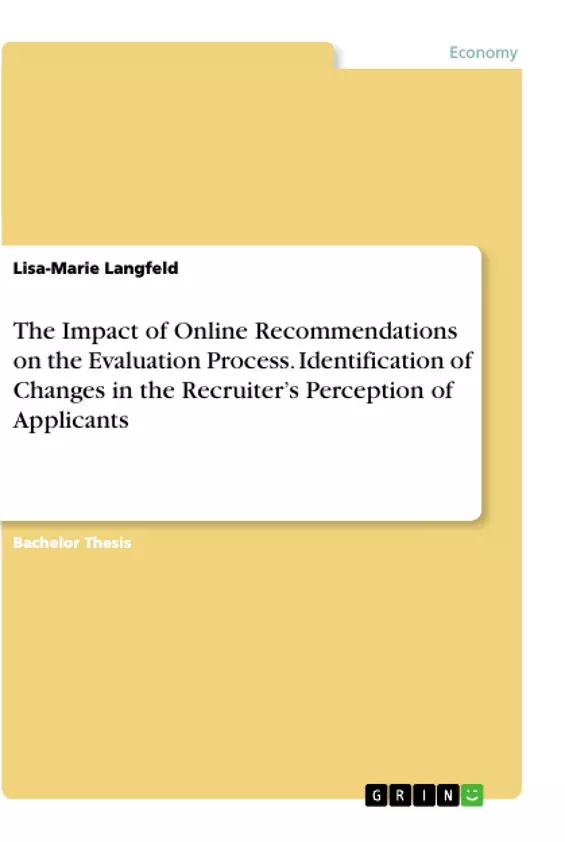Human Resources practices are undergoing major changes driven by technology innovations, especially with regards to the evaluation process. Social networking sites and the vast amount of freely available information about individuals allow for extensive conclusion drawing before even meeting a candidate. Although 97% of recruiters said they have used LinkedIn as a selection and recruiting tool back in 2012 already, there has been little empirical research conducted on how social networks influence the process. The paper on hand focuses on the role of the well-known business network ‘LinkedIn’, the accuracy of information provided online and more precisely on the credibility of recom-mendations submitted online. The overarching goal is to identify changes in recruiter’s perception of a candidate with regards to quantity, quality and source of online recommendations.
By taking into account various studies and selected literature regarding the influence of recommendations on the selection process, the author gained extensive understanding of previously identified factors and their respective impact. In addition, a primary study in form of an online survey has been conducted among recruiters to receive insights into the evaluation process in today’s recruiting divisions.
Outcomes reveal that attributing value to online recommendation in inevitable in nowadays selection practices. Moreover, the recommendation donor has a profound impact on the credibility: family and friends are not deemed credible whereas work-related parties such as co-workers and immediate management are favored and their assessment is validated. Lastly, the quantity of recommendations does not hold significant value with regards to assessing credibility.
Inhaltsverzeichnis (Table of Contents)
- How Professional Social Networking Sites influence Recruiting Processes
- Literature-based Findings for the Role of Recommendations in the Evaluation Process and Background Knowledge about Online Social Networks
- Role of Recommendations in the Screening and Selection Process
- Research Background and Terminology
- Literature Review: Usage of Recommendations
- Social Networking Sites in Evaluation Processes: Focus on the Professional Network LinkedIn
- Definition
- Capabilities and Objectives of Social Networking Sites for the HR Department
- Role of Recommendations in the Screening and Selection Process
- Identifying the Influence of LinkedIn Recommendations on the Evaluation Process: Primary Study Goal, Design and Results
- Status Quo and Goal of the Primary Study
- Primary Study: Usage of Online Recommendations in the Evaluation Process
- Design and Execution of the Online Survey
- Sample Size
- Results of the Online Survey
- Findings, Optimization Recommendations and Future Development of Professional Networks for Selection Purposes
- Role of LinkedIn Recommendations on Selection Processes
- Evaluation Recommendations
- Limitations and Future Utility
Zielsetzung und Themenschwerpunkte (Objectives and Key Themes)
This bachelor's dissertation explores the impact of online recommendations, specifically from LinkedIn, on the evaluation process in human resource management. The study aims to identify how the quantity, quality, and source of online recommendations influence a recruiter's perception of a candidate.
- The growing importance of social networking sites in recruitment
- The role of online recommendations in the evaluation process
- The credibility of online recommendations based on their source
- The influence of recommendation quantity on recruiter perception
- The impact of online recommendations on traditional HR practices
Zusammenfassung der Kapitel (Chapter Summaries)
- Chapter 1 introduces the research topic and highlights the increasing relevance of social networking sites in recruitment practices.
- Chapter 2 delves into the existing literature concerning the role of recommendations in the evaluation process and provides background information on online social networks, particularly LinkedIn.
- Chapter 3 outlines the primary study's objective, design, and results. It explores the usage of online recommendations in the evaluation process and analyzes data from an online survey conducted among recruiters.
- Chapter 4 examines the findings of the study, presents optimization recommendations for utilizing LinkedIn recommendations in selection processes, and discusses future development of professional networks for recruitment purposes.
Schlüsselwörter (Keywords)
The primary focus of this dissertation is on the evaluation process in recruitment, specifically examining the influence of online recommendations provided through professional social networking sites, such as LinkedIn. The research explores the role of these platforms in enhancing or altering traditional HR practices, emphasizing the impact of recommendation quantity, quality, and source on a recruiter's perception of a candidate. The study investigates the credibility of online recommendations and their effect on the selection process.
- Arbeit zitieren
- Lisa-Marie Langfeld (Autor:in), 2016, The Impact of Online Recommendations on the Evaluation Process. Identification of Changes in the Recruiter’s Perception of Applicants, München, GRIN Verlag, https://www.grin.com/document/535907



